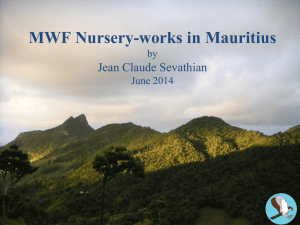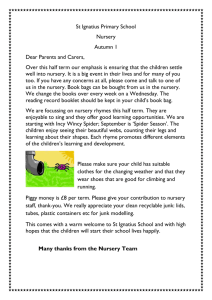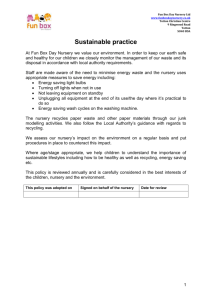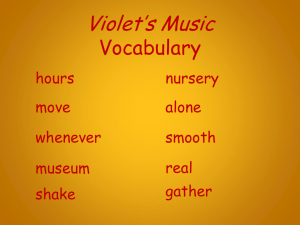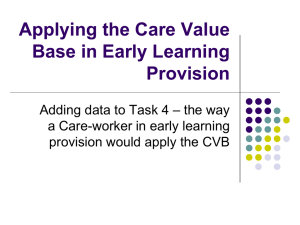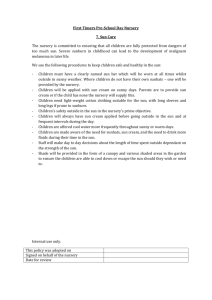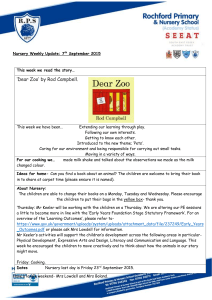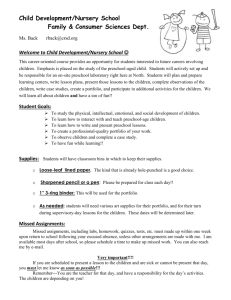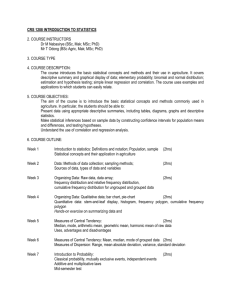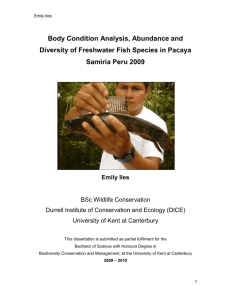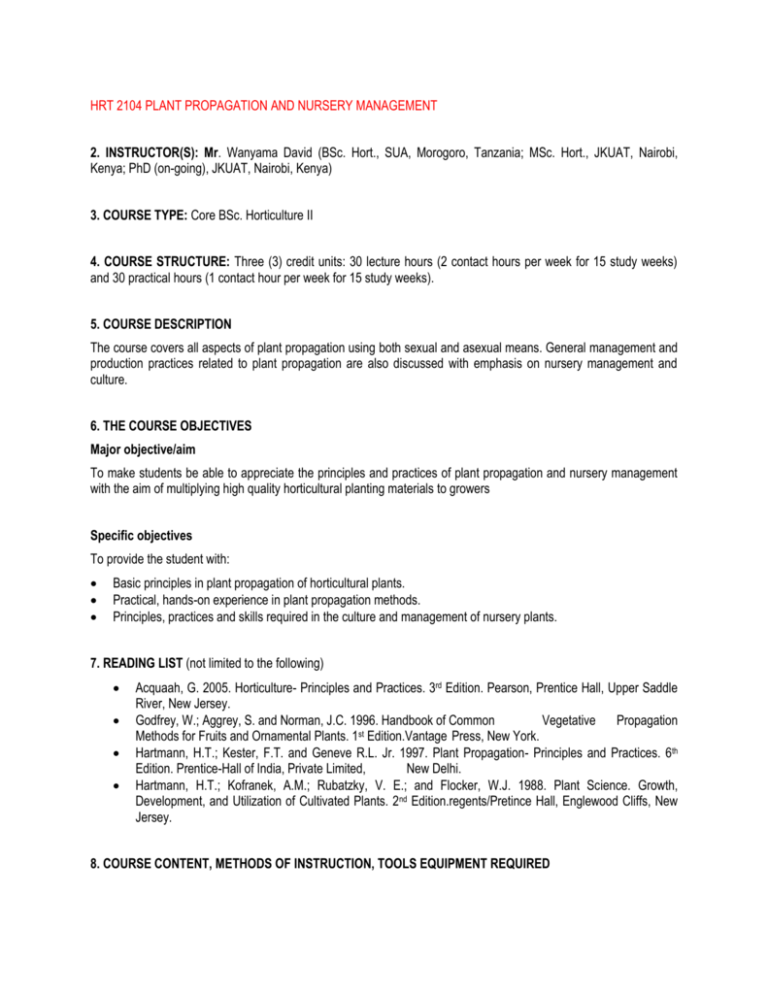
HRT 2104 PLANT PROPAGATION AND NURSERY MANAGEMENT
2. INSTRUCTOR(S): Mr. Wanyama David (BSc. Hort., SUA, Morogoro, Tanzania; MSc. Hort., JKUAT, Nairobi,
Kenya; PhD (on-going), JKUAT, Nairobi, Kenya)
3. COURSE TYPE: Core BSc. Horticulture II
4. COURSE STRUCTURE: Three (3) credit units: 30 lecture hours (2 contact hours per week for 15 study weeks)
and 30 practical hours (1 contact hour per week for 15 study weeks).
5. COURSE DESCRIPTION
The course covers all aspects of plant propagation using both sexual and asexual means. General management and
production practices related to plant propagation are also discussed with emphasis on nursery management and
culture.
6. THE COURSE OBJECTIVES
Major objective/aim
To make students be able to appreciate the principles and practices of plant propagation and nursery management
with the aim of multiplying high quality horticultural planting materials to growers
Specific objectives
To provide the student with:
Basic principles in plant propagation of horticultural plants.
Practical, hands-on experience in plant propagation methods.
Principles, practices and skills required in the culture and management of nursery plants.
7. READING LIST (not limited to the following)
Acquaah, G. 2005. Horticulture- Principles and Practices. 3rd Edition. Pearson, Prentice Hall, Upper Saddle
River, New Jersey.
Godfrey, W.; Aggrey, S. and Norman, J.C. 1996. Handbook of Common
Vegetative
Propagation
Methods for Fruits and Ornamental Plants. 1st Edition.Vantage Press, New York.
Hartmann, H.T.; Kester, F.T. and Geneve R.L. Jr. 1997. Plant Propagation- Principles and Practices. 6th
Edition. Prentice-Hall of India, Private Limited,
New Delhi.
Hartmann, H.T.; Kofranek, A.M.; Rubatzky, V. E.; and Flocker, W.J. 1988. Plant Science. Growth,
Development, and Utilization of Cultivated Plants. 2nd Edition.regents/Pretince Hall, Englewood Cliffs, New
Jersey.
8. COURSE CONTENT, METHODS OF INSTRUCTION, TOOLS EQUIPMENT REQUIRED
TOPIC
CONTENT
1. General introduction to
plant propagation
2. Sexual/seed propagation
(Seedage)
propagation
4. Grafting and budding
(Graftage)
5. Layering/layerage
6. Micropropagation
Interactive
(1hr)
/
Lecture
Black board and
Chalk
Overview of seedage
Advantages and disadvantages
Polyembryony versus apomixis
Seed description, collection, processing,
testing and storage
Seed dormancies, sowing and seedling
transplating
Lecture ( 3 hrs)
Black board and
Chalk
Overview of cuttage
Advantages and disadvantage
Factors affecting rooting of cuttings
Types of cuttings
Lecture
Black board and
Chalk
Terminology in grafting
Importance of grafting
Principles of grafting
Polarity in grafting and limits of grafting
Scion and rootstock selection
Techniques of grafting
Overview of layering
Factors which enhance layering
Types of layering
3. Cutting
(Cuttage)
Definition of plant propagation
Why plants are produced in a nursery
Ways of propagating horticultural plants
METHOD
OF TOOLS
INSTRUCTION / Time EQUIPMENT
allocated
NEEDED
(2 hrs)
Black board and
Chalk
Lecture (2hrs)
Lecture (2hrs)
Black board and
Chalk
Overview of micropropagation
Characteristics/advantages and
disadvantages of micropropagation
Lecture (2hrs)
Black board and
Chalk
History of plant nurseries
Importance of plant nurseries
Why plants are produced in nurseries
Lecture (2hrs)
Black board and
Chalk
Classification
by
Ownership,
Function, Production system, and
Type of plant material produced
Lecture (2hrs)
Black board and
Chalk
Lecture (2hrs)
Black board and
Chalk
Quiz 1
7. General Introduction to
the nursery industry
8. Nursery Classification
9.
Establishment
of
nursery/ nursery site and
location
Nursery site characteristics
Factors affecting nursery location
10.Organization
and development of
the nursery site
Nursery design
Designing
for
effective
environmental management
Lecture (2hrs)
Black board and
Chalk
11. The Nursery Growing
Media
Soil and nutrient management for fieldgrown nursery plants
Media and Nutrient Management for
Container-Grown Nursery Plants
12.
Irrigation
(Water
management) of Nursery
Crops
13. Modifying Plant
Growth
and
Development in the
Nursery
Water supply and its sources
Water treatment
Interactive
Lecture
Water recycling
(2hrs)
Irrigation systems
Developing a thicker stem or trunk
Making a plant taller
Developing a compact root system
Developing compact, bushy growth
Improving foliage color and vigor
Encouraging flower development
Using chemical growth regulators to modify Lecture (2hrs)
plant growth
Using light to modify plant growth Making
flower out of season (Effects of
Environmental factors)
Integrated Pest Management
Identifying the problem
Identifying pests
Identifying diseases
Interactive Lecture
Quiz 2
(2hrs)
14. Pest and Disease
Management in the Nursery
15. Practical sessions
Field-based practical on propagation techniques
(grafting, layering, cutting, tissue culture)
Interactive
(2hrs)
Lecture
Black board and
Chalk
Black board and
Chalk
Black board and
Chalk
Black board and
Chalk
All
materials
provided
by
research
institutes
Transport for 25
students
16-17:
Preparation for University Examinations
9. SUMMARY OF THE REQUIRED TIME
Lectures
28 hrs
Quizzes
2 hours
Practical
30 hrs
10. COURSE ASSESSMENT
Continuous
(quizzes)
assessment 2 quizzes will be done during 6th and 14th weeks of the semester
20%
Continuous assessment A practical report will be prepared on the various propagation techniques 20%
(Practical report)
covered during practical sessions in the 15th week of the semester.
University Examination
This will be done between the 16th and the 17th weeks of the semester
60%


